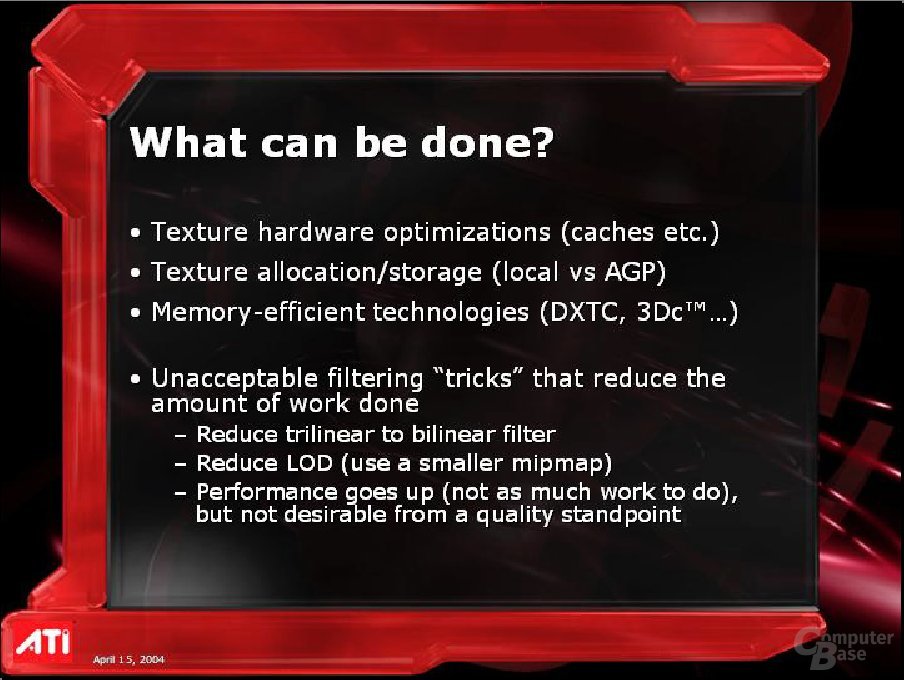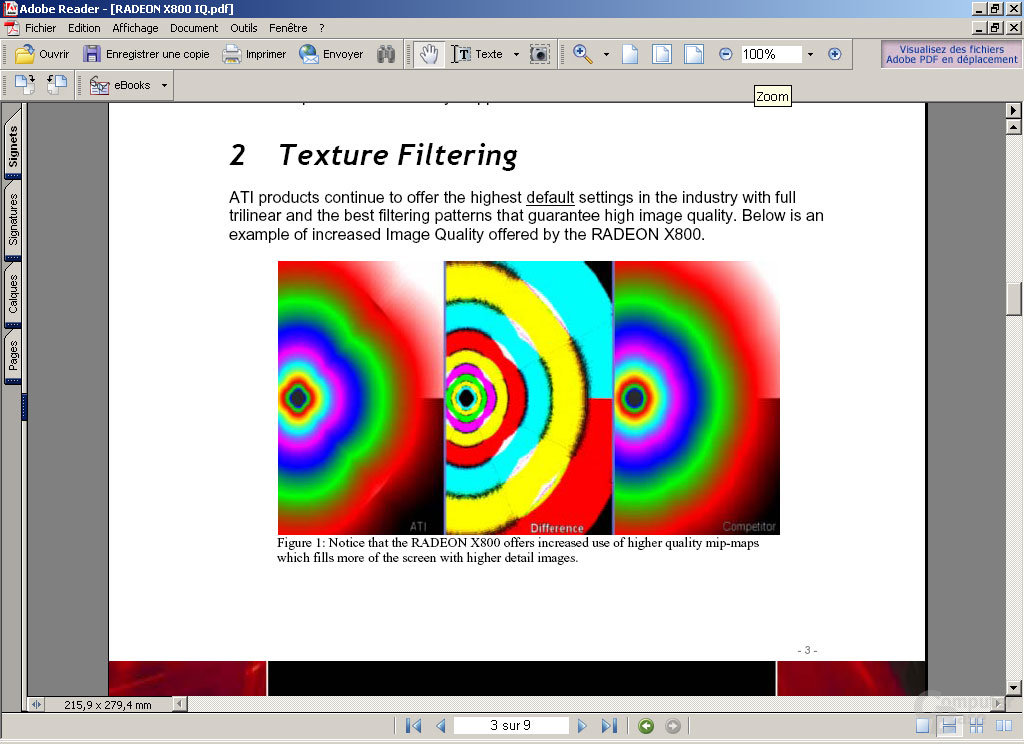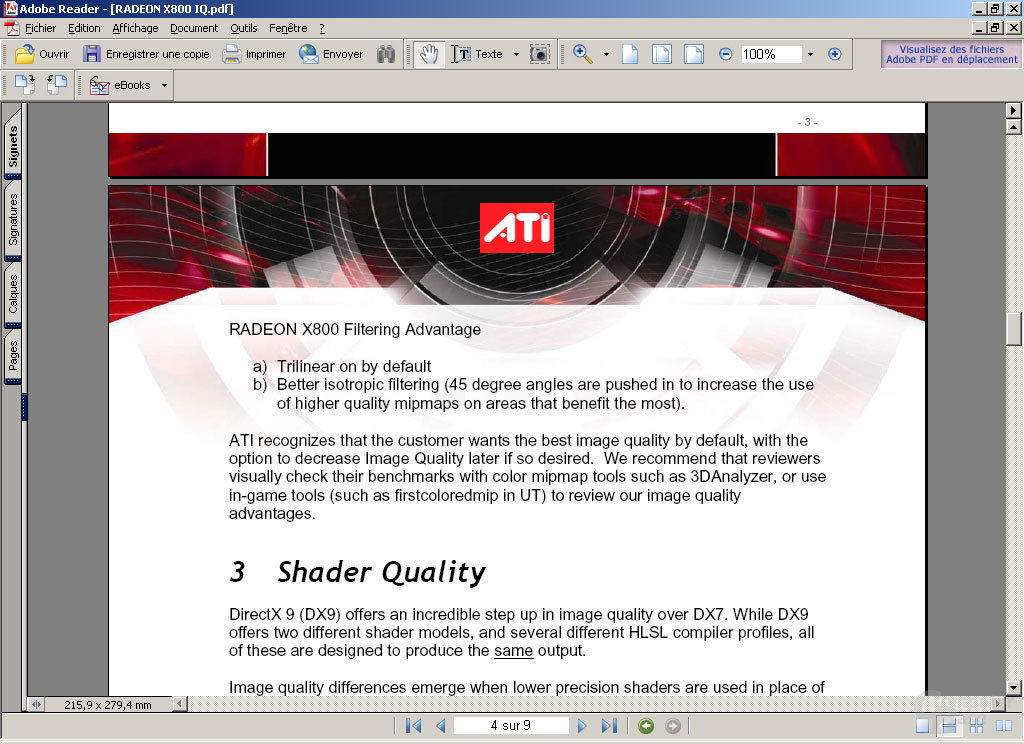Offizielles ATi-Statement zur Texturfilterung
Nach einer ersten Reaktion von Richard Huddy am gestrigen Montag, welche allerdings nicht speziell auf die ColorMip-Angelegenheit bezogen war, gab es heute eine offizielle Stellungnahme von ATi zu unserem Artikel.
There has been a lot of discussion about our trilinear filtering algorithms recently.
The objective of trilinear filtering is to make transitions between mipmap levels as near to invisible as possible. As long as this is achieved, there is no "right" or "wrong" way to implement the filtering.
We have added intelligence to our filtering algorithm to increase performance without affecting image quality. As some people have discovered, it is possible to show differences between our filtering implementations for the RADEON 9800XT and RADEON X800. However, these differences can only be seen by subtracting before and after screenshots and amplifying the result. No-one has claimed that the differences make one
implementation "better" than another.
Our algorithm for image analysis-based texture filtering techniques is patent-pending. It works by determining how different one mipmap level is from the next and then applying the appropriate level of filtering. It only
applies this optimization to the typical case - specifically, where the mipmaps are generated using box filtering. Atypical situations, where each mipmap could differ significantly from the previous level, receive no
optimizations. This includes extreme cases such as colored mipmap levels, which is why tests based on color mipmap levels show different results.
Just to be explicit: there is no application detection going on; this just illustrates the sophistication of the algorithm.
We encourage users to experiment with moving the texture preference slider from "Quality" towards "Performance" - you will see huge performance gains with no effect on image quality until the very end, and even then, the effect is hardly noticeable. We are confident that we give gamers the best
image quality at every performance level.
Microsoft does set some standards for texture filtering and the company's WHQL process includes extensive image quality tests for trilinear filtering and mipmapping. CATALYST passes all these tests - and without application detection, which could be used if you wanted to get a lower-quality algorithm go undetected through the tests.
Finally, ATI takes image quality extremely seriously and we are confident that we set the bar for the whole industry. We don't undertake changes to our filtering algorithms lightly, and perform considerable on-line and
off-line image analysis before implementing changes. This algorithm has been in public use for over a year in our RADEON 9600 series products, and we have not received any adverse comments on image quality in that time. If anyone does find any quality degradation as a result of this algorithm, they are invited to report it to ATI. If there is a problem, we will fix it.
Da es nun eine offizielle Erklärung gibt, werden wir unseren Schluß, ein Erkennungsmechanismus zur Entdeckung colorierter Mip-Levels sei hier am Werk, erst einmal zurücknehmen - soviel sind wir der Fairness schuldig.
Daß allerdings ein 500-Millionen-Dollar-Konzern Asche auf ihr Haupt streut und reuig Besserung gelobt, war allerdings auch nicht ernsthaft zu erwarten. Das Statement von ATi klingt erstaunlicherweise vom Tenor her ähnlich, wie seinerzeit nVidia das Vorhandensein des reduziert-trilinearen Filters bei der GeForceFX - natürlich sei man nur daran interessiert, dem Endkunden das bestmögliche visuelle Erlebnis mit nicht wahrnehmbaren visuellen Einbussen zu bieten.
Trotzdem möchten wir darauf hinweisen, daß wir die Einführung einer solchen „Verbesserung“ für nicht wünschenswert halten, solange dem Endkunden die Möglichkeit verwehrt wird, diese bei Nichtgefallen abzuschalten.
Nach einer kleinen Auswertung dessen, was es sonst noch an Statements bezüglich der Texturfilterung von ATis Seite gibt, sind wir auf folgende Seiten in diversen PDF-Dateien gestossen, die User auch im Forum von Beyond3D gepostet haben.
Vorerst wollen wir diese Angelegenheit jedoch nicht weiter kommentieren.



